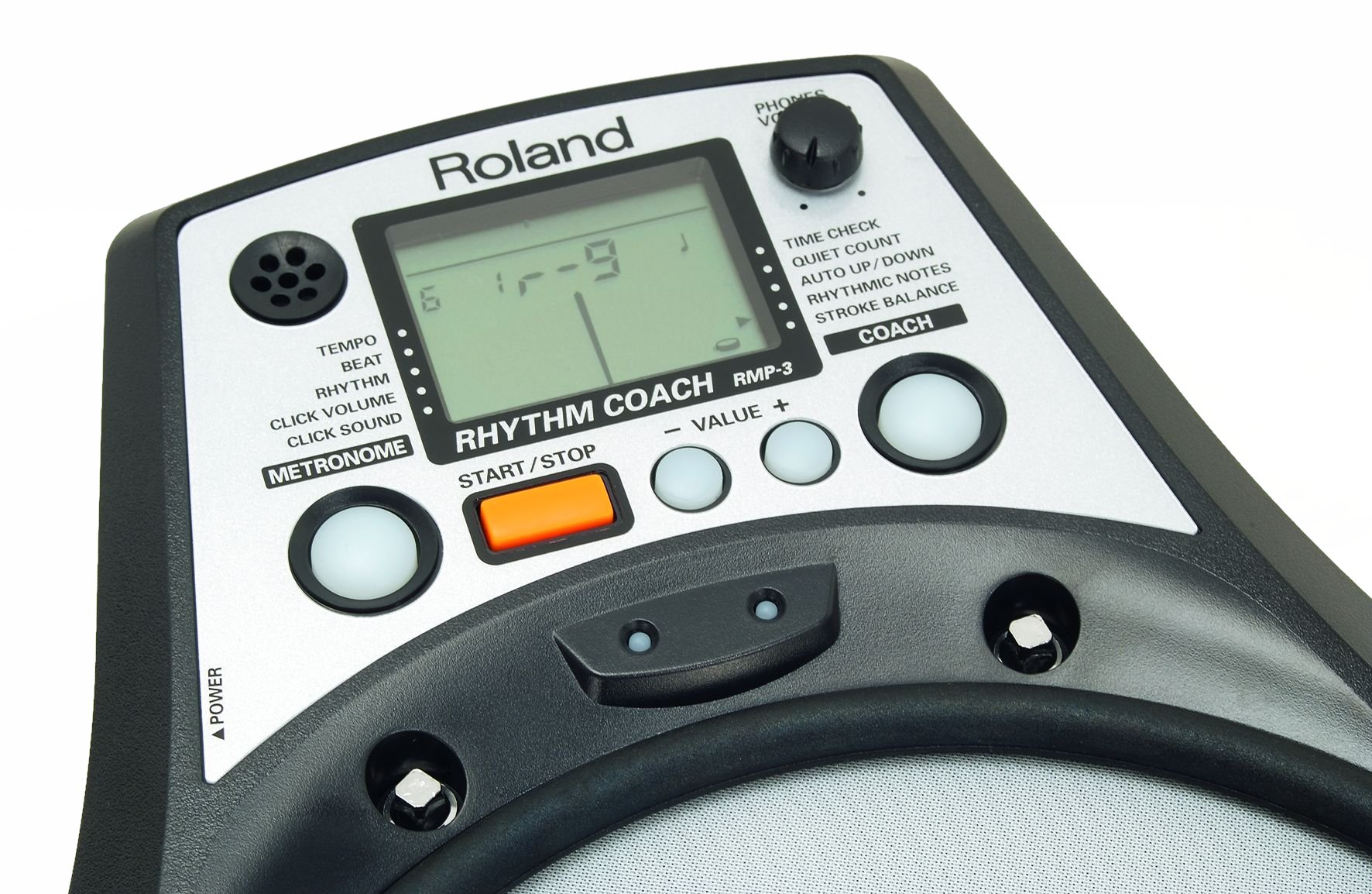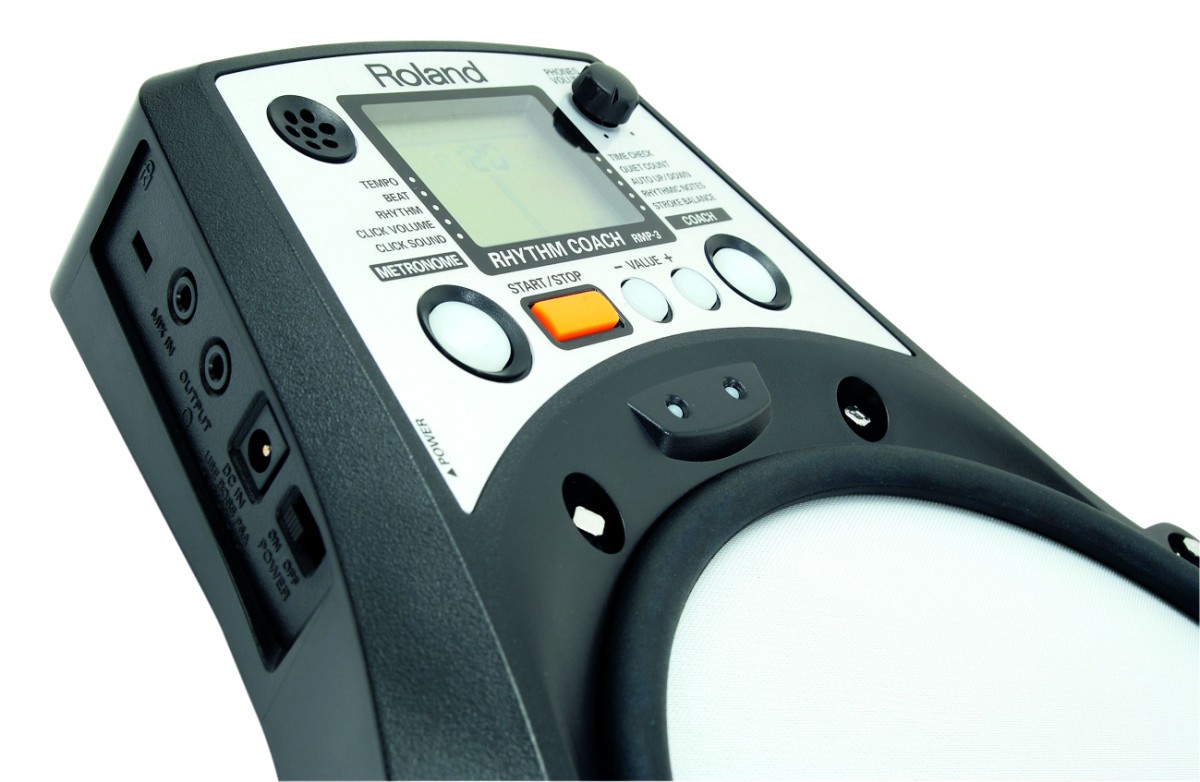MusicRadar Verdict
Given the added value of a mesh head and the versatile Rhythm Coach functions, the RMP-3 is well worth consideration if you are serious about getting the most out of your practice time. The fact that it can be powered by battery as well as mains, works well on a desktop or mounted on a stand and features a headphone output means it's extremely flexible and, a couple of niggles aside, both well-conceived and executed.
Pros
- +
Affordable. Challenging and fun. Portable practice/warm-up tool
Cons
- -
Only a couple of minor gripes.
MusicRadar's got your back


Whatever did we do before the invention of the metronome? The absence of that steady tick tock for musicians - especially drummers - to practise against is almost unthinkable now. From the swinging pendulums so beloved of piano teachers to the all-singing and dancing electronic units produced by Korg, Yamaha, Roland and others, the metronome has been a necessary part of the serious musician´s arsenal for a long while.
The other staple of the improving drummer´s practice kit is, of course the practice pad. The bane of every non-drumming member of a drummer´s household, the regular pitter patter of stick on pad marks out the committed from the casual. Roland´s new RMP-3 is, basically, a combination of these two essential tools. At its heart, it is a metronome strapped to a practice pad. However, it is the highest-tech incarnation of such an affair.
The very nature of the RMP-3 means that, as a concept, it´s to be applauded. Anything that makes it easier, more fun and more convenient to get down and do some serious woodshedding and chop-honing is to be praised. And the fact that the RMP-3 is relatively small, battery operable and boasts a decent spec sheet, means it should score well on the ease, fun and convenience fronts…
Clear vision
As far as drum training devices are concerned, Roland has a good track record. Roland's V-Drums are an excellent concept geared towards effective practice, and it´s good to see the design ethos of that product are present here. The RMP-3´s goals are clearly defined, and while it´s a flexible unit, it doesn´t over-stretch itself. It exists to help you become a better player and that´s it.
As such, all of its features are practice-oriented. Although it might look like a trigger pad from a distance, it doesn´t contain any built-in sounds, nor does it allow the triggering of an external sound source via MIDI. The pad itself is simply a playing surface - when you´re playing through headphones a sensor under the mesh head picks up the acoustic sound of stick on head, but without headphones no electronically produced sound emanates from the RMP-3´s pad.
The small speaker to the left of the LCD screen is for metronome output and, while it might be teeny, the piercing beep of the metronome cuts through with plenty of clarity for most situations. In fact there are three variations on the beep sound for you to choose from. All of them basic and purposeful rather than being sonically engaging (in as much as they all sound like a metronome), but at least there´s some variety to be had.
Want all the hottest music and gear news, reviews, deals, features and more, direct to your inbox? Sign up here.
There are a fair few parameters to play with to ensure that time-keeping practice doesn´t get too tedious. In terms of tempo, the RMP-3´s metronome covers 20-260bpm, there are a host of time signatures to select from and the incessant tick tock can be set to sound on everything from whole notes through 16ths, to quintuplets, sextuplets and various clave patterns.
The way that these choices are made - and indeed the manner in which the RMP-3 operates in general - is pretty straightforward. It´s simply a case of hitting the metronome button on the left of the unit to move the on-screen cursor to the function (tempo, beat, rhythm, click volume, click sound) that you want to change and using the value plus and minus buttons to alter it. It´s all very intuitive.
Coaching tactics
One of the main selling points of the RMP-3 is the addition of Rhythm Coach features alongside the metronome. Rather than hammering away with the click as you would with a standalone pad and metronome, the RMP-3 includes features designed to help gauge progress and provide a real rhythmic workout. To this end there are five modes listed on the right of the screen with enigmatic titles - Time Check, Quiet Count, Auto Up/Down, Rhythmic Notes and Stroke Balance.
Time Check is fairly simple - it tells you how far ahead or behind the beat you are with each stroke, as judged against the metronome. The display screen shows arrows to indicate just how hopeless you´re being, with a ‘good´ legend illuminating when your strokes are bang on the money. Rhythmic Notes cycles through various note values for two bars at a time - starting with half-notes, then quarters, halves, up to 16ths and then back to halves again - and Stroke Balance gives a visual read-out as to the difference between the striking force of your right and left hands.
The development of your own internal clock is helped by the Quiet Count function, which has the metronome bleeping away for a certain number of bars, then going silent for a while to let you keep time on your own before striking up again, and Auto Up/Down is designed to build stamina by increasing or decreasing tempo at various beat or bar intervals.
Electro-acoustic
The electronic aspects of the RMP-3 have been well considered, although it´s not without niggles. The LCD screen isn´t backlit, which makes it hard to read in low-light situations (such as backstage) and if you´re working on an exercise and hit the Coach or Metronome buttons, the metronome stops sounding. As such you can´t make alterations to the click sound, volume, and other settings without stopping and starting again.
But back to the good stuff. One of the most welcome non-electronic aspects of the RMP-3 is the use of a mesh-head as a playing surface. This means much less intrusive noise for those around you when you get the practice bug in the middle of the night, and a far more enjoyable, realistic playing sensation as compared to a rubber pad. The Remo co-designed head is even tensionable, so you can get close to the feel of your snare head with the RMP-3, making for seamless Green Room to stage transitions.
MusicRadar is the number 1 website for music makers of all kinds, be they guitarists, drummers, keyboard players, djs or producers...
GEAR: We help musicians find the best gear with top-ranking gear round-ups and high- quality, authoritative reviews by a wide team of highly experienced experts.
TIPS: We also provide tuition, from bite-sized tips to advanced work-outs and guidance from recognised musicians and stars.
STARS: We talk to musicians and stars about their creative processes, and the nuts and bolts of their gear and technique. We give fans an insight into the actual craft of music making that no other music website can.
